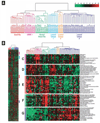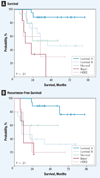Biology, metastatic patterns, and treatment of patients with triple-negative breast cancer
- PMID: 19596646
- PMCID: PMC2919761
- DOI: 10.3816/CBC.2009.s.008
Biology, metastatic patterns, and treatment of patients with triple-negative breast cancer
Abstract
Of the estimated 1 million cases of breast cancer diagnosed annually worldwide, it is estimated that over 170,000 will harbor the triple-negative (estrogen receptor/progesterone receptor/HER2-negative) phenotype. Most, though not all, triple-negative breast cancers will be basal-like on gene expression micorarrays. The basal-like molecular subtype exhibits a unique molecular profile and set of risk factors, aggressive and early pattern of metastasis, limited treatment options, and poor prognosis. Large population-based studies have identified a higher proportion of triple-negative breast tumors among premenopausal African American women, and a suggestion that increased parity, younger age at first-term pregnancy, shorter duration of breast feeding, and elevated hip-to-waist ratio might be particular risk factors. When BRCA1 mutation carriers develop breast cancer, it is usually basal-like; given the central role of BRCA1 in DNA repair, this could have profound therapeutic implications. When diagnosed, triple-negative breast cancers illustrate preferential relapse in visceral organs, including the central nervous system. Although initial response to chemotherapy might be more profound, relapse is early and common among triple-negative breast cancers compared with luminal breast cancers. The armamentarium of "targeted therapeutics" for triple-negative breast cancer is evolving and includes strategies to inhibit angiogenesis, epidermal growth factor receptor, and other kinases. Finally, the positive association between triple-negative breast cancer and BRCA mutations makes inhibition of poly(adenosine diphosphate-ribose) polymerase-1 an attractive therapeutic strategy that is in active study.
Figures


References
-
- Perou CM, Sørlie T, Eisen MB, et al. Molecular portraits of human breast tumours. Nature. 2000;406:747–752. - PubMed
-
- Swain SM. Triple-negative breast cancer: metastatic risk and role of platinum agents. Paper presented at: 44th Annual Meeting of the American Society of Clinical Oncology; May 30-June 3, 2008; Chicago, IL.
-
- Nielsen TO, Hsu FD, Jensen K, et al. Immunohistochemical and clinical characterization of the basal-like subtype of invasive breast carcinoma. Clin Cancer Res. 2004;10:5367–5374. - PubMed
Publication types
MeSH terms
Substances
Grants and funding
LinkOut - more resources
Full Text Sources
Other Literature Sources
Medical
Research Materials
Miscellaneous

